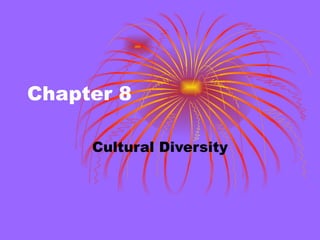
Chapter 8
- 1. Chapter 8 Cultural Diversity
- 2. Historical perspectives • Notion of the melting pot – salad bowl • Some groups have avoided assimilation (Amish, Navajo, Hassidic Jews, Hopi) • Many groups find that assimilation occurs
- 3. Cultural Contributions • Native American number of languages spoken • Importance of religion and learning by doing • Fasting, meditating, dancing, using natural drugs • Many lack proficiency in English • Significant influence in areas where tribes are located and languages spoken • Science, food (corn, potatoes, peanuts came to make up 60% of European diet!) • Example – Navajo Nation
- 5. Hispanic/Latino • First what is the difference? Does it matter? • Coming from 21 countries but with some common language, religious beliefs and practices, holidays, and life patterns • Importance of interdependence and cooperation of immediate and extended family
- 6. Latino Americans • Mexican, Puerto Rican, Cuban, South American, or other Spanish culture • Are not a homogeneous socioeconomic & educational group • May suffer economic deprivation • Are affected negatively by socioeconomic conditions of the family • Share (many of them) Spanish • language & culture
- 8. APIs or APAs: Asian Pacific Islanders or Americans • 29 groups-Pacific Islanders (Hawaiians, Somoans, Guamamians); Southeast Asians (Vietnamese, Thai, Cambodian, Laotian, Burmese, Phillipino); East Asian (Chinese, Japanese, Korean); South Asian (Indian, Pakistani) • Characteristics • Often quiet, taught not to question teacher • Respect for elders, delayed gratification, discipline • Teachers afforded high esteem
- 9. APAs: What teachers can do to help • Delay or hesitation in response – as result of unfamiliarity • Frequent topic shifts/poor topic maintenance-not know rules • Inappropriate nonverbal expressions- avoid eye contact; frown for concentration; giggle from embarrassment • Short responses – may be too shy • Use of soft-spoken voice-loud voice sometimes = disrespect • Taking few risks – fear of ridicule • Lack of participation-Asian classroom volunteering info bold • Embarrassment over praise – regard humility instead of greeting and self-criticism • Atypical greeting rituals – may appear impolite or unfriendly because they look down (out of respect or
- 10. Parents • Trust educational authorities & don’t get involved in school • Feel they should not interfere • High achievement brings honor to the family • Learning disabilities and depression seen to be physical sickness resulting from lack of motivation • Time seen as a cure for certain ills; may schedule time with you and arrive late w/o apology
- 11. Arab Americans
- 12. Arab Students • 18 countries in North Africa and Western Asia sharing common culture, most speaking Arabic or dialects of Arabic • Religion may be very important: ISLAM May be around 2 million Arab-Americans immigrating since 1945 (Palestinians, Lebanese, depending on political events & war) • Muslims may wish to pray 5X a day – allow time for prayer • Fast from dawn to sunset during Ramadan – 2006, Ramadan began on 9/23 lasting until 10/22 in the lunar year 1427 (2006) The new moon times to be used for determining the beginning and ending of Ramadan are given below for UT (Universal time) – also called GMT (Greenwich Mean Time). • 11:45 a.m. on September 22, 2006 • 5:14 a.m. on October 22, 2006
- 13. Arab Students • Allow students to wear appropriate clothing for gym. Allow girls to wear hijab • Watch out for pork or marshmallows, lard, gelatin, or animal shortening • May need to be absent for religious holidays • Some do not celebrate birthdays • Be aware of traditional and religious American and Christian holidays (students may not know what Easter eggs are!)
- 15. Eastern Europeans • Many left due to political upheaval in 1990s (remember, Berlin Wall?) • Jewish immigrants have left eastern Europe (particularly Russia) in increasing numbers • Russian students may be those who are from various former republics as well as ethnic Russians • Most left due to economic hardships, religious persecution, civil war, among others
- 16. Changing Population • 2010 one of every three Americans will be African-American, Hispanic American, or Asian American • Poverty – 24% African-American and 22% Hispanic-American living in poverty – see table 8.2 • Education of minorities: many ELL come to inner city schools with high rates of poverty – evidence showing that these students do not do as well as others in more well funded locations • Spanish, Vietnamese, Hmong, Korean, Arabic, Haitian Creole and the list continues
- 17. Why immigration? • War, famine, civil strife, economic changes, persecution and other factors • After Vietnam War, SE Asians were displaced and US government took role in taking care of them, Civil war in Latin America (El Salvador) • Waves of immigration • Religious reasons • Changes in migration: California used to attract 33% of all immigrants, now only 22% • Newer immigrants settling in Oregon, Arizona, Iowa, Arkansas, Georgia, North Carolina, Kentucky, Tennessee, and Virginia
- 18. Immigration Laws & Policy • Limit for family-sponsored preference immigrants = 226,000 & employment 140,000 • Some immigrants wait for 12 years or more (China, India, Mexico & Philippines) • Legal status – documented • Immigrants from Cambodia, Laos, Vietnam, and Thailand usually have refugee status • 1986 Immigration Reform and Control Act states undocumented children are legally entitled to a public education
- 19. Organization of Multicultural- sensitive classroom regardless of national origin • Major concepts should be written down • Should not be erased or referred back to • Writing on the board = legible • Handouts and guides help ELL students so they can follow • Videos, visuals, realia • Modeling of every activity • Checking for background knowledge – schema • REMEMBER: Profile of Effective Teaching in a Multilingual Classroom video!